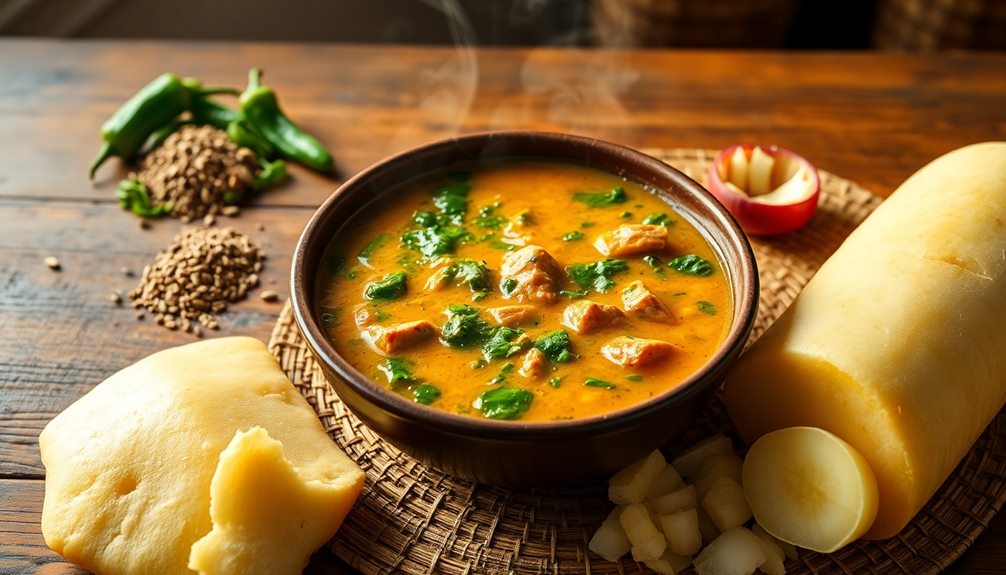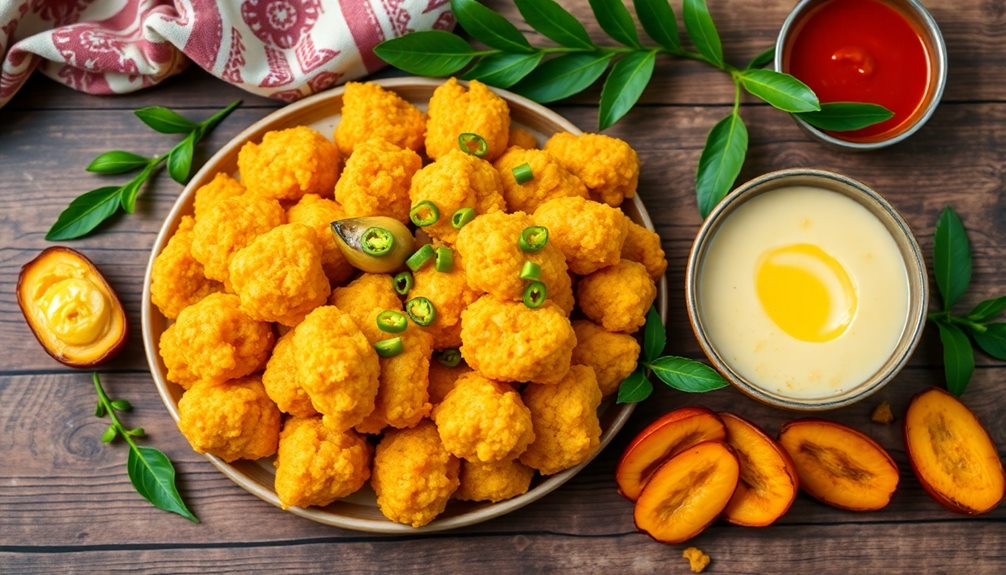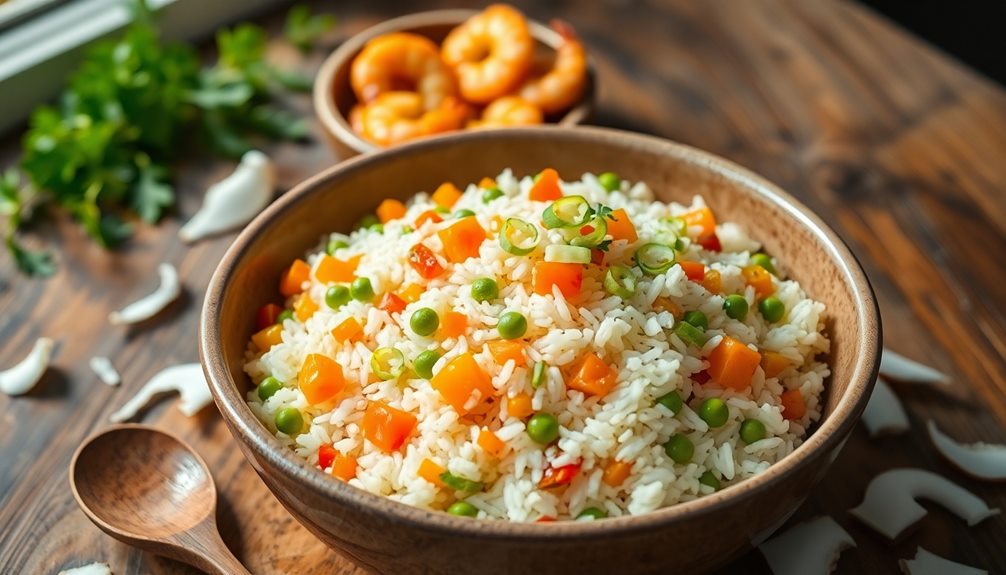Ewedu and Gbegiri are two amazing Nigerian soups that work perfectly together! Ewedu brings a smooth, velvety texture and a unique flavor, while Gbegiri adds a hearty and creamy touch from mashed beans. When you mix them, you create a delicious combination that warms your heart and brings family and friends together. You'll love how easy they are to prepare. First, you blend Ewedu leaves, then simmer them with meat or fish. Gbegiri is made by mashing cooked beans and adding spices. If you're curious about the steps to enjoy this delightful pairing, stick around to learn more!
Key Takeaways
- Ewedu and Gbegiri soups showcase Nigeria's rich culinary heritage, combining unique flavors and traditions from various regions.
- Ewedu is made from jute leaves, while Gbegiri is a nutritious bean soup, creating a complementary texture and taste when served together.
- The preparation involves blending Ewedu leaves and mashing cooked beans, with added seasonings for depth of flavor in both soups.
- These soups are often enjoyed with side dishes, fostering connection and storytelling among family and friends during shared meals.
- Nutrient-packed and comforting, Ewedu and Gbegiri are perfect for any occasion, celebrating the essence of Nigerian cuisine.
History
Exploring the history of Nigerian soups reveals a rich tapestry of cultural influences and regional variations. You might be surprised to learn that these delightful dishes have been enjoyed for centuries! Each region in Nigeria has its own unique flavors and ingredients, shaped by local customs and traditions. For instance, the Yoruba people often use vegetables like ewedu, while the Igbo might prefer oha leaves.
These soups not only nourish the body but also tell stories of the people who make them. They've been passed down through generations, each family adding its special touch. You can imagine a grandmother teaching her grandchildren how to prepare a warm, comforting bowl of soup, sharing secrets and memories along the way.
As you dive into the world of Nigerian soups, you'll notice how they reflect the country's diverse cultures. From the spicy pepper soup to the savory gbegiri, each dish offers a taste of history.
You'll find that these soups are more than just food; they unite friends and families, bringing everyone together over a shared meal. So, get ready to explore these delicious dishes and their fascinating backgrounds!
Cooking Steps
Cooking delicious Nigerian soups involves a series of straightforward yet essential steps that ensure rich flavors and satisfying textures.
First, gather your ingredients! For Ewedu, you'll need fresh Ewedu leaves, water, and spices like locust beans and salt. For Gbegiri, have some cooked beans, stock, and seasonings ready.
Next, wash the Ewedu leaves thoroughly, then blend or pound them until smooth. In a pot, add water and bring it to a boil. Stir in the blended leaves, add locust beans, and season with salt. Let it simmer for about 15-20 minutes, allowing the flavors to blend beautifully.
Meanwhile, for Gbegiri, mash the cooked beans until you get a creamy consistency. In another pot, heat your stock and mix in the mashed beans. Add spices and let it cook for about 10-15 minutes.
Once both soups are ready, serve them together! Pour Gbegiri into a bowl and add Ewedu on top. Enjoy the delightful flavors and textures with your favorite side dish, like pounded yam or rice.
Step 1. Prepare Fresh Ewedu Leaves
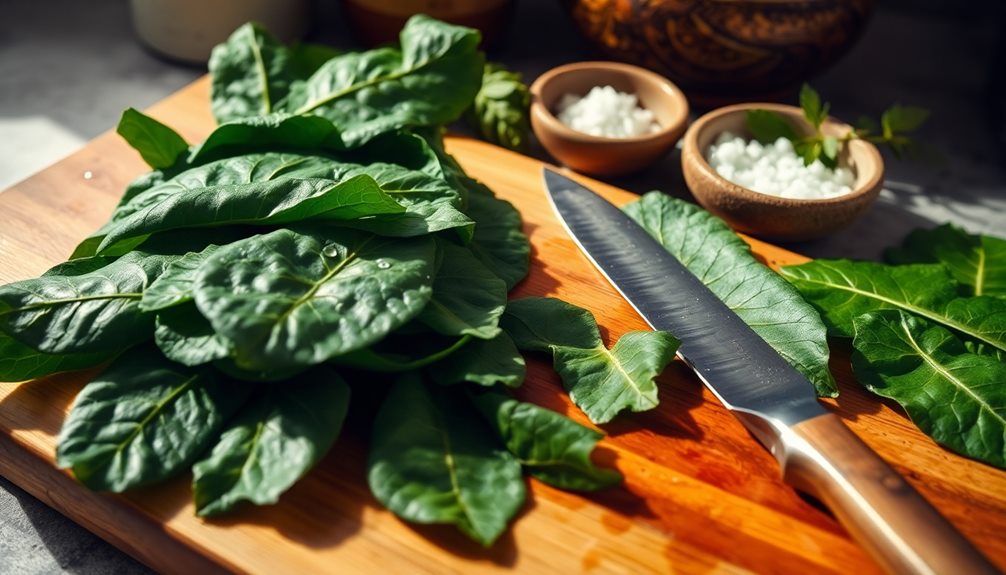
Fresh ewedu leaves are the star ingredient in a delicious bowl of jute soup, and preparing them properly is essential for the best flavor and texture.
First, gather a bunch of fresh ewedu leaves from your local market or garden. Look for vibrant green leaves without any yellow or brown spots.
Once you have your leaves, rinse them thoroughly under cold running water. This removes dirt and any tiny bugs hiding among the leaves.
After washing, gently shake off excess water and place the leaves on a clean cutting board. Now, it's time to trim! Use a sharp knife to cut off the tough stems and any discolored parts.
Next, stack a few leaves on top of each other and slice them into smaller pieces. You want them to be about one inch wide. This makes it easier to cook and eat later on.
Step 2. Blend Ewedu With Water
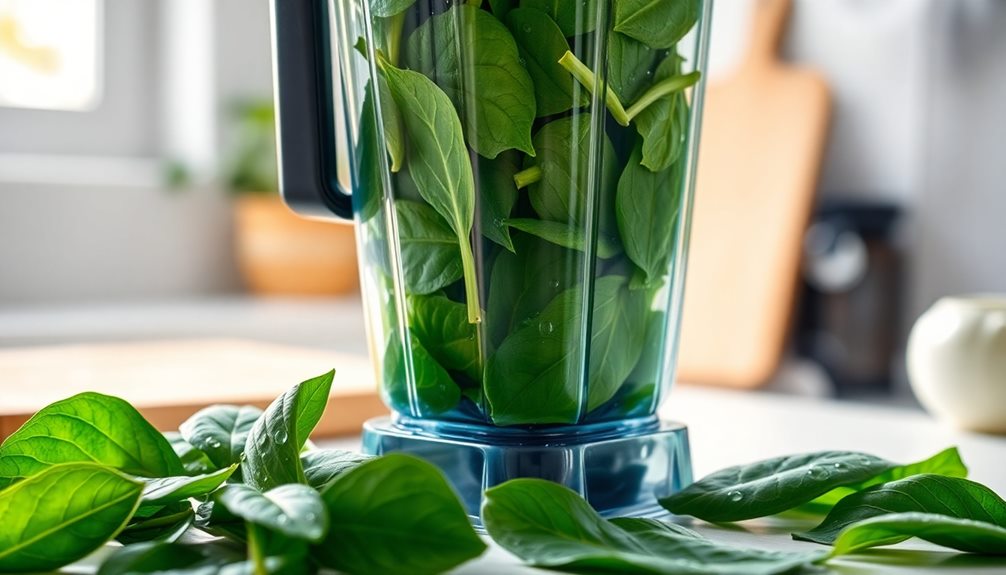
To achieve a smooth and flavorful jute soup, you'll want to blend the prepared ewedu leaves with a bit of water.
Start by gathering your ingredients: the fresh ewedu leaves, some clean water, and a blender. If you don't have a blender, a mortar and pestle will work too!
Next, place the ewedu leaves into the blender. Make sure you don't overload it; it's better to blend in batches if you have a lot.
Add just enough water to help the blending process. You want the mixture to be smooth, but not too watery.
Once you've added the water, secure the lid tightly. Turn on the blender and watch the magic happen!
Blend until you have a velvety green puree. If you're using a mortar and pestle, mash the leaves together with some water until you achieve a similar consistency.
After blending, pour the ewedu mixture into a bowl, and admire the vibrant color!
You're now ready to take the next step in creating your delicious jute soup. It's getting exciting, isn't it? Enjoy every moment of cooking!
Step 3. Add Locust Bean Seasoning
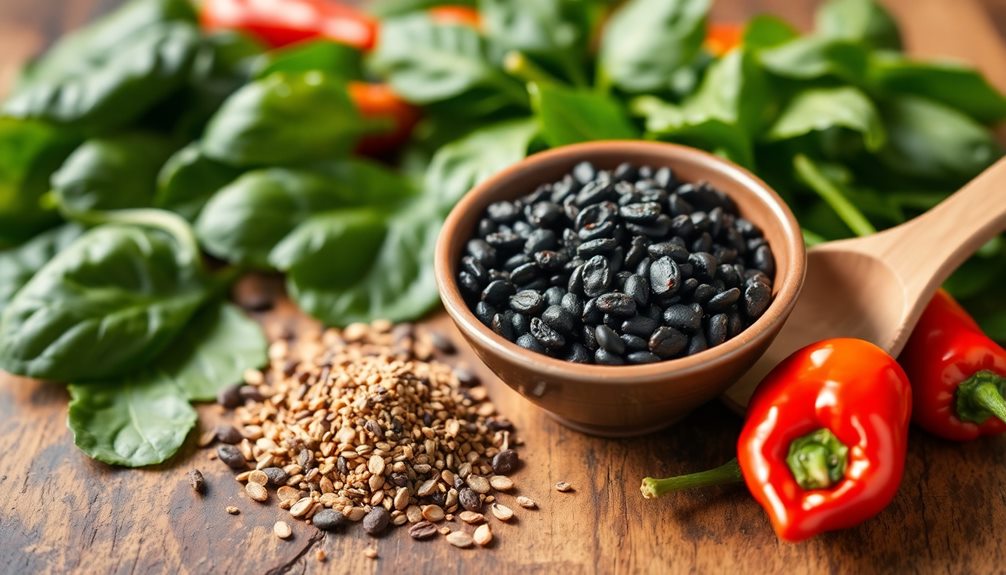
Once you've got your seasoning ready, sprinkle it into the pot with your blended jute leaves.
Stir it in gently, allowing the seasoning to mix well with the soup. As you stir, you'll notice a beautiful aroma filling your kitchen—this is the magic of locust bean!
It's important to let the locust bean simmer for a few minutes. This helps release its full flavor, enhancing the overall taste of your soup.
While you wait, take a moment to enjoy the delightful scents wafting around. It's a sign that you're on your way to a fantastic meal!
Step 4. Simmer With Meat or Fish

Now that your soup is infused with the rich flavors of locust bean, it's time to enhance it further by adding your choice of meat or fish. This step is super exciting because it brings hearty goodness to your dish! You can choose from chicken, beef, goat, or even fish. Each option adds its own special flavor.
First, if you're using meat, cut it into bite-sized pieces. Then, add it to your pot and let it simmer on medium heat. This allows the meat to soak up all those delicious soup flavors.
If you prefer fish, add it a little later, so it doesn't break apart too much.
While everything cooks, make sure to stir occasionally. This helps everything blend together, making your soup even tastier! You'll notice the aroma filling your kitchen, making your tummy rumble in anticipation.
Cook the meat until it's tender, usually about 30-40 minutes, depending on what you chose. If you're using fish, let it simmer for about 10-15 minutes.
Once everything's cooked, you're almost ready for the final touches! Enjoy the delightful journey of flavors as your soup comes together.
Step 5. Adjust Consistency With Water
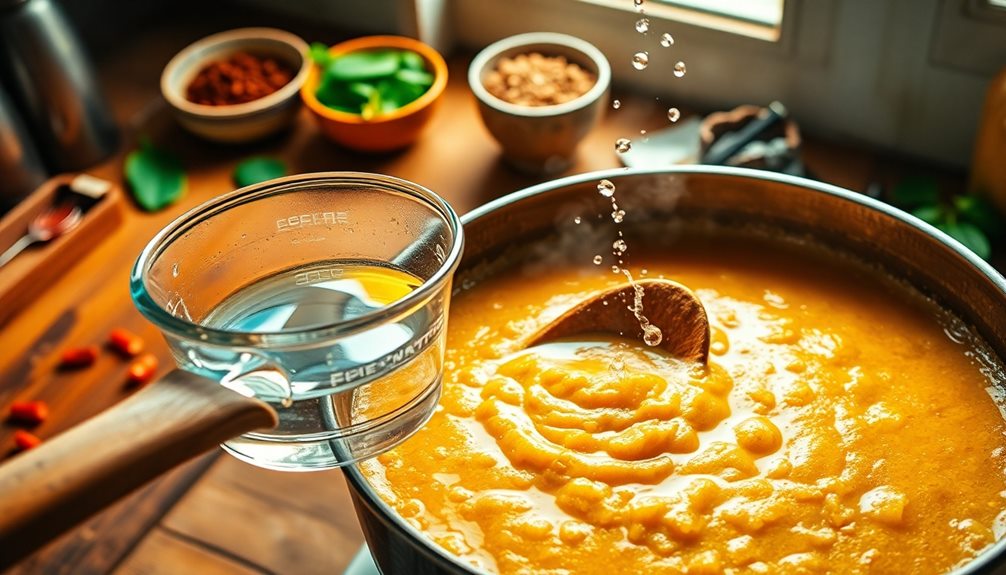
After your meat or fish has simmered to perfection, you might find the soup needs a little adjustment in consistency.
Don't worry, fixing it's super easy! Just grab a cup of warm water and add it slowly to your pot. As you pour, stir the soup gently. This way, you can see how the texture changes, making sure it's just right for you.
If your soup feels too thick, keep adding water until it reaches the consistency you love. Remember, you want a nice, smooth, and slightly thick soup that'll coat your spoon perfectly.
On the other hand, if it's too watery, don't panic! You can let it simmer for a bit longer to thicken it up.
Taste your soup along the way, too! This will help you figure out if you need to add a pinch of salt or any other spices to amp up the flavor.
Cooking is all about finding what makes you happy. So, enjoy the process of adjusting your soup, and soon you'll have a delicious bowl of Ewedu or Gbegiri ready to serve!
Final Thoughts
As you explore the rich world of Nigerian soups, it's clear that these dishes are more than just meals; they're a vibrant tapestry of culture and tradition.
Ewedu and Gbegiri, in particular, showcase the beauty of Nigerian cuisine. When enjoyed together, they create a delightful mix of flavors and textures that can warm your heart and satisfy your taste buds.
Imagine sitting down with family or friends, sharing stories, and enjoying a hearty bowl of these soups. You can feel the love and history in every spoonful.
Plus, the health benefits of these soups can't be overlooked! Packed with nutrients, they're also comforting and delicious, making them perfect for any occasion.
Frequently Asked Questions
What Are the Health Benefits of Ewedu and Gbegiri?
Ewedu and gbegiri offer numerous health benefits. You'll find they're rich in vitamins, minerals, and fiber, promoting digestion and boosting immunity. They also provide essential nutrients, supporting overall health and well-being in your diet.
Can Ewedu and Gbegiri Be Frozen for Later Use?
Yes, you can freeze both ewedu and gbegiri for later use. Just ensure they're cooled completely before transferring them to airtight containers. When you're ready to eat, simply thaw and reheat thoroughly.
What Side Dishes Pair Well With Ewedu and Gbegiri?
When enjoying your meal, consider pairing it with jollof rice, fried plantains, or pounded yam. These sides complement the flavors beautifully, enhancing your dining experience and making it more satisfying and delicious.
Are There Vegetarian Versions of Gbegiri?
Yes, you can make vegetarian versions of gbegiri using plant-based proteins like tofu or lentils. Just substitute traditional ingredients while maintaining the flavor profile, and you'll have a delicious, meat-free option that everyone can enjoy.
How Can I Adjust the Spice Levels in These Soups?
To adjust the spice levels in your soups, start by adding spices gradually. Taste as you go, and remember you can always add more, but it's tough to tone down heat once it's there.
